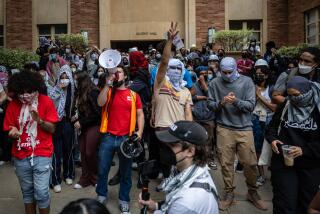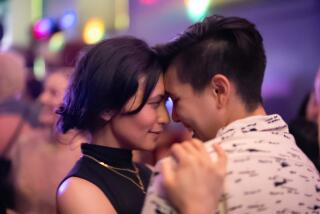Chicago gays torn over place of their own
- Share via
CHICAGO — A cliche that ranks right up there with “Windy City,” “City of the Big Shoulders” and “That Toddling Town” is the oft-intoned sentiment that Chicago is the “City of Neighborhoods.”
The municipal government has long backed up that slogan with public works celebrating the special nature of various slices of the metropolis. Chinatown has its pagodas and arches. Greek Town sports classical columns at the entrance. A huge sculptural rendition of the Puerto Rican flag spans Division Street as it runs through Humboldt Park.
Recently, the time came for the city to widen sidewalks and plant trees along North Halsted Street, home to businesses like the Manhole, the pink-awninged Gay Mart and Ram: A Gay Treasure. The project designers thought they would reflect the community by adding two 25-foot gateways and some 200 street pylons, all adorned with lighted rings in the same colors as the stripes of the rainbow Gay Pride flag.
In the process, Mayor Richard M. Daley’s administration is setting a precedent, casting Chicago as the first city in the nation to place a gay neighborhood on the same plane as an ethnic neighborhood--and proposing to spend nearly half a million taxpayer dollars to do so.
Planners insist that they never expected the least hint of controversy to attend the tribute, part of a $3.2-million refurbishment. “We just wanted to make sure we preserve the character of the neighborhood,” said Mary Morten, Daley’s liaison to the gay and lesbian communities. “We meant it as a thank you, an acknowledgment to the businesses that helped turn this area around.”
Some people are thrilled by the implicit acceptance. “I love it,” said the Gay Mart’s Shelly Rosenbaum.
Some others clearly are not.
Among the disconcerted and dismayed, as you might expect, are preachers and conservatives, appalled by what appears to be the city seal of approval on behavior they see as sin.
As you might not expect, debate is also fierce among homosexuals.
“It’s recognition, yet at the same time, it’s ghettoizing,” said David Rouse, a 51-year-old librarian emerging from Ram. “Gays and lesbians live in a lot of different neighborhoods.”
Rouse’s home turf, for example, is Andersonville to the north, once predominantly Swedish and now experiencing an influx of homosexuals. And suburban Oak Park, to the west, has such a large gay population that it recently enacted a same-sex partnership registry.
Friends, Rouse said, have voiced the flip side to his concern: “They’re asking, ‘Are straight people going to come here anymore?’ ” He shrugged. “Not that I care.”
The rainbow motif already runs rampant along the eight blocks of North Halsted designated for sprucing up. The colors show up in flags and banners flying over bars, a home store and a video shop. Banners--a procession of red, yellow, green and purple--hung by the private Northalsted Area Merchants Assn. declare the zone “a PROUD community!”.
“You know what?” said Rosenbaum. “You have to be blind, deaf or dumb not to know that this is a gay neighborhood.” And it was gay businesses, he noted, that transformed the street from a seedy, gang-ridden stretch 20 years ago into the vital commercial strip it is today.
North Halsted runs down the center of an 8-by-4-block area with 20 gay and lesbian bars, one of the largest concentrations in the nation. Gays have bought residential property on surrounding streets. “They’re not renting. They’re not going anywhere. It’s not going to change,” said Ben Allen, a director of the merchants group.
Critics agree, but add that the city project “looks too official,” in the words of Richard Majko, a 47-year-old registered nurse.
The designers say they were trying to be subtle. “We thought about other symbols, like the inverted pink triangle, but we liked that the rainbow has other associations beyond the gay community,” said lead architect Edward Windhorst. “It means diversity.”
Mike Dublak, 36, and Sharon Authier, 31, help make North Halsted diverse. They are a heterosexual couple.
Although “I get whistled at,” Dublak said, grinning, they have no complaints about renting an apartment in a place with many gay overtones. But while Authier would welcome wider sidewalks, she draws the line at the rainbow rings and sculptures: “That money could be spent on other things.”
Still, signatures are piling up on petitions in support of a city-sanctioned “over the rainbow” district. Said Allen: “There are 3,600 miles of streets in the city of Chicago. I think the gay and lesbian community would not be overrepresented to have less than three-quarters of a mile of these streets.”
More to Read
Sign up for Essential California
The most important California stories and recommendations in your inbox every morning.
You may occasionally receive promotional content from the Los Angeles Times.













